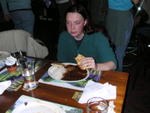In case you hadn’t guessed, the destroyed tent I posted a picture of to my blog a few days ago wasn’t Jimmy‘s at all, but another tent we saw while on the Abnib Real Ale Ramble. Jimmy has since gotten his
revenge by ensuring I play Medieval II: Total War, which has occupied most of my life since we got back. Pictures from the entire weekend, mostly taken on JTA‘s (borrowed) camera, which
had a habit of turning itself off without warning, are available on Abnib Gallery.
In the end, it was only Ruth, JTA, Claire and I that went to Llanwrtyd Wells for the Real Ale Ramble this year. Claire
and I borrowed Jimmy’s tent and camped on the local rugby pitch, where the toilet/shower block (which doubles as the local scout troop hut) was unlocked for us. Of the three nights we
camped, there were only other people camping there on one night: three tents appeared a little way from ours during our first day’s rambling, and disappeared again the following
morning. The temperature was tolerable, given our heavy-duty sleeping bags, but the torrential hailstorms made camping a more exciting experience than we had anticipated, and it almost
became necessary to re-peg the tent during one of the more violent storms.
Ruth & JTA, meanwhile, set themselves up at Ardwyn House, a B&B near the self-catering cottage in which we stayed last year.
I’ll leave it to them to describe the comparative life of luxury they were allowed to live there. Still; it must be said that our campsite had a higher showers-to-guest ratio than them,
so perhaps we win after all. On our final night, after returning from the pub, we all had a great and very tense game of Illuminati in
the library (yes, their B&B had a library) and drank champagne to celebrate Ruth & JTA having been together for approximately three years. Again, suppose that’s more something for
them to blog about.
We did the 15-mile ramble on the first day, which remains, like last year, about twice as hard or more as the 10-mile walk (which we
did on the second), even without a broken foot. The pouring rain of the previous few days – accompanied by scattered showers on the first day – resulted in very wet conditions, and at
times the mudslides made it difficult to stay in the same place, never mind making progress up an embankment. On several humorous occasions one or another of us would lose our balance
and hurtle down into the mud, but we were prepared for this with waterproof or semi-waterproof clothing pretty-much all round. The number of “beer tokens”, each worth half a pint of
beer (also exchangeable for hot and cold drinks and, sometimes, soup) was reduced this year to three per day, but the enforcement had been relaxed, and on the second day I recall that
Ruth drank three pints of Cambrian Ale without handing over a single token while we sat at a picnic bench by a river.
The evenings took us, predictably, to the Neuadd Arms, for a great number of interesting beers (Over The Edge, Red Dragon, Cambrian Ale,
Russian Stoat, and a few others come to mind as being well-worth-tasting) – and some equally interesting conversation with strange and unusual people: we met a man who’s life was taken
over by bonsai trees, a woman who graduated in Biology from Aberystwyth in 1985, and a lecturer who’d “disappeared” from his classes to come along to the festival, among others – but
also, this year, to the Stonecroft Inn, where, in a gazebo out the back of the pub, they had a fabulous selection of ales, ciders and perries
to try, as well as a flamethrower-like space heater that felt wonderful to stand in front of after a wet day in the hills.
Norman, the 70-something old man who beat us around both walks last year, was around again, and still
managed to get around the walk faster than us, although we might have beaten him on the second day were it not for the abandoned beer tent at Station 1 and, therefore, the temptation to
hang around for a second drink before hitting the trail again. He is, as I put it at the time, “a one-man walking machine,” before I realised how stupid that sounded. A few other
familiar faces were to be seen, too: folks we’d seen last year giving knowing nods as if to say, “Ah, it’s you again.” Although, more often, they were saying things like “You’re
camping? In this?”
One final highlight of the weekend that I’ll share with you is of a meal at the Neuadd Arms. On their menu they list a number of curry dishes, all rated by heat with a series of
“radiation” symbols by each, from one to three. Except for their Phaal, which has five, and promises a medal to anybody who can clear their plate. Claire, being Claire, tried it. She
didn’t manage to clear her plate, but that’s probably for the best, because the room was starting to feel warm and tingly as a result of the heat exuded by the dish. We all
tried a taste of it, once she’d admitted defeat, which was quite painful – but tasty. Claire’s promised to get herself into “curry training” for next year.
Right; time to start planning the Abnib Real Ale Ramble 2007!
Further Reading






 A Real Eye-Opener by C. Waltham
A Real Eye-Opener by C. Waltham
 Good, but not great by bookworm331
Good, but not great by bookworm331
 i dont get it by whiner
i dont get it by whiner
